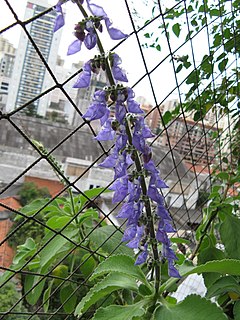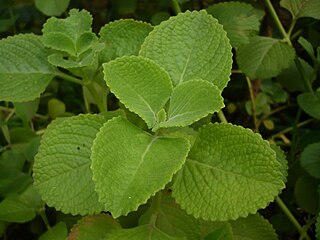
The Lamiaceae or Labiatae are a family of flowering plants commonly known as the mint or deadnettle or sage family. Many of the plants are aromatic in all parts and include widely used culinary herbs like basil, mentha, rosemary, sage, savory, marjoram, oregano, hyssop, thyme, lavender, and perilla, as well as other medicinal herbs such as catnip, salvia, bee balm, wild dagga, and oriental motherwort. Some species are shrubs, trees, or, rarely, vines. Many members of the family are widely cultivated, not only for their aromatic qualities, but also their ease of cultivation, since they are readily propagated by stem cuttings. Besides those grown for their edible leaves, some are grown for decorative foliage. Others are grown for seed, such as Salvia hispanica (chia), or for their edible tubers, such as Plectranthus edulis, Plectranthus esculentus, Plectranthus rotundifolius, and Stachys affinis. Many are also grown ornamentally, notably coleus, Plectranthus, and many Salvia species and hybrids.

Solenostemon is a former genus of flowering plants in the family Lamiaceae. It has been included in the genus Plectranthus, but is now included in an expanded Coleus. They are native to tropical Africa, Asia and Australia. Some species formerly placed in this genus are cultivated for their highly variegated leaves.

Coleus rotundifolius, synonyms Plectranthus rotundifolius and Solenostemon rotundifolius, commonly known as native or country potato in Africa and called Chinese potato in India, is a perennial herbaceous plant of the mint family (Lamiaceae) native to tropical Africa. It is cultivated for its edible tubers primarily in West Africa, as well as more recently in parts of Asia, especially India, Sri Lanka, Malaysia, and Indonesia.

Plectranthus, with some 72 species, is a genus of herbaceous perennial plants, rarely annuals or soft-wooded shrubs, sometimes succulent; sometimes with a tuberous base. Common names include spur-flower. Plectranthus species are found in Southern and Tropical Africa and Madagascar, and one in Sri Lanka.

Vitex is a genus of flowering plants in the mint family Lamiaceae. It has about 250 species. Common names include chaste tree or chastetree, traditionally referring to V. agnus-castus but often applied to other species as well.

Coleus barbatus, also known by the synonyms Plectranthus barbatus and incorrectly Coleus forskalaei, is a tropical perennial plant related to the typical coleus species. It produces forskolin, an extract useful for pharmaceutical preparations and research in cell biology.

Coleus caninus, synonym Plectranthus caninus, is a herb from the mint family Lamiaceae, native to southern and eastern Africa from Angola to Sudan and to India and Myanmar.

Coleus scutellarioides, commonly known as coleus, is a species of flowering plant in the family Lamiaceae, native to southeast Asia through to Australia. Typically growing to 60–75 cm (24–30 in) tall and wide, it is a bushy, woody-based evergreen perennial, widely grown for the highly decorative variegated leaves found in cultivated varieties. Another common name is painted nettle, reflecting its relationship to deadnettles, which are in the same family. The synonyms Coleus blumei, Plectranthus scutellarioides and Solenostemon scutellarioides are also widely used for this species.
Coleus cataractarum, synonym Plectranthus cataractarum, is a species of flowering plant in the family Lamiaceae. It is found in Cameroon and Equatorial Guinea. Its natural habitats are subtropical or tropical moist lowland forests and rivers, near waterfalls. It is threatened by habitat loss.
Coleus dissitiflorus, synonym Plectranthus dissitiflorus, is a species of flowering plant in the family Lamiaceae. It is found only in Cameroon. Its natural habitat is subtropical or tropical dry forests. C. dissitiflorus is threatened by habitat loss.
Coleus socotranus, synonym Plectranthus socotranus, is a species of flowering plant in the family Lamiaceae.
Coleus unguentarius, synonym Plectranthus socotranus, is a species of flowering plant in the family Lamiaceae. It is found only in Namibia. Its natural habitat is rocky areas. It is threatened by habitat loss.
Coleus maculosus subsp. edulis, synonym Plectranthus edulis, the Ethiopian potato, known as welayta dinich in Amharic, is a species of annual plant in the family Lamiaceae. It is indigenous to Ethiopia, where it is grown for its edible tubers. The tubers are cooked before they are eaten.

Coleus is a genus of annual or perennial herbs or shrubs, sometimes succulent, sometimes with a fleshy or tuberous rootstock, found in the Old World tropics and subtropics. The relationship among the genera Coleus, Solenostemon and Plectranthus has been confused. Coleus and Solenostemon were sunk into Plectranthus, but recent phylogenetic analysis found Plectranthus to be paraphyletic with respect to other related genera in the subtribe Plectranthinae. The most recent taxonomic treatment of the genus resurrected Coleus, and 212 names were changed from combinations in Plectranthus, Pycnostachys and Anisochilus. Equilabium was segregated from Plectranthus, after phylogenetic studies supported its recognition as a phylogenetically distinct genus.

Capitanopsis is a genus of plants in the family Lamiaceae, first described in 1916. It contains six known species, all endemic to Madagascar.

Coleus fredericii, synonym Plectranthus welwitschii, is a species of plant in the family Lamiaceae. The epithet is also spelt frederici.
Equilabium is a genus of flowering plants in the family Lamiaceae. It was split off from the genus Plectranthus in 2018 as the result of a molecular phylogenetic study. Most species are native to Africa, with two found in the Indian subcontinent.
Coleus maculosus is a species of flowering plant in the family Lamiaceae. It is widespread in tropical Africa and Madagascar.

Capitanopsis brevilabra is a species of flowering plant in the family Lamiaceae. It was formerly treated as the only species, Dauphinea brevilabra, in the genus Dauphinea. A phylogenetic study in 2018 found that it was embedded in the genus Capitanopsis, and it was transferred to that genus. It is native to Madagascar.
Capitanopsis magentea is a species of flowering plant in the family Lamiaceae. It was formerly treated as the only species, Madlabium magenteum, in the genus Madlabium. A phylogenetic study in 2018 found that it was embedded in the genus Capitanopsis, and it was transferred to that genus. It is native to Madagascar.










